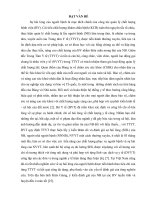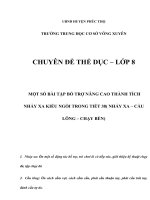The capital market Purpose of the capital market For long term investment Capital market participants
Bạn đang xem bản rút gọn của tài liệu. Xem và tải ngay bản đầy đủ của tài liệu tại đây (117.27 KB, 22 trang )
The capital market
Purpose
of the capital
market
For long-term investment
Capital market participants
Federal and local governments
Corporations
Largest purchasers :
Households
Capital market trading
Occurs in either the Primary Market
or the Secondary Market
Primary Market
Secondary Market
Organized exchange
Over-the-counter exchange
Organized securities exchange
An organized exchange has a building
where securities ( stocks, bonds,
options, futures) trade.
Largest organized securities exchange in
USA:
NewYork stock exchange (NYSE)
- Minimum requirement to
list on the NYSE:
At least 2000 stockholders , each owning
100 shares or more;
A minimum of 1.1 million shares traded
publicly;
Pretax earning of $ 2.5 million at the time of
listing plus at least $ 2 million in pretax
earning in each of the prior two years
Net asset of $ 18 million
A total of $ 18 million in market value of
publicly traded shares
Over-the counter market:
securities not listed on one of the
exchange trade in the over-thecounter market.
Trading occurs over a sophisticated
telecommunication network (National
Association of securities Dealers
Automated Quotation System –
NASDAQ)
Capital market securities:
Bonds
The capital market are where securities with
original maturities of greater than one year
trade.
Capital market securities: bonds, stocks and
mortgages
Bonds are securities that represent a debt owed
by the issuer to the investor.
Par, face, maturity value of the bond is the
amount that the issuer must pay at maturity.
The coupon rate is the rate of interest that the
issuer must pay. This rate is usually fixed for
the duration of the bond and does not fluctuate
with market interest rate.
Treasury bonds
Notes have an original maturity of 1 to 10 years
Bonds -------------------------10 to 30-Notes & bonds are free of default risk but not
risk free.
Treasury bond interest rates: very low because
no default risk
Treasury STRIPS (Separate trading of
registered interest and principal securities)
+ interest payment
+ principal repayment (zero-coupon bond)
Agency bond
Issuer of agency bonds include:
the government national mortgage
association,
the farmers home administration,
the federal housing administration...
characteristic:
low risk
interest is higher than treasury
securities due to the lower liquidity
Municipal bonds:
Issued by local, county and state government
Purpose: to finance public interest project
( schools, transportation systems...)
+ advantage: low interest because it is taxexempt bond
+Tax-free municipal interest rate = taxable
interest rate x (1 – marginal tax rate)
Ex: taxable corp. Bond interest rate : 9 %
Marginal tax rate : 28%
Equivalent tax-free rate for an investor is
9% x (1 – 0,28) = 6,48%
Types
General obligation bond: do not have
specific assets pledged as security or a
specific source of revenue allocated for
their repayment. The issuer promises to use
every resource available to repay the bond.
revenue bonds: repay by cash flow of a
particular revenue-generating project. (high
risk)
note: municipal bonds have default risk
(local government cannot print money)
Corporate bonds
issuer: large corp.
Face value: $ 1000 ;
Pay interest : semi-annually
Can be redeemed anytime the issuer
wishes
Bond indenture: a contract that states the
lenders rights and privileges and the
borrowers obligations.
degree of risk : very difference between
corp.
Difference of interest.
Characteristics of Corp. Bonds
Bearer bonds , registered bonds
+ Bearer bonds: payment were made to
whoever had physical possession of the bonds
+ registered bonds: do not have coupons.
Owner must register with the firm to receive
interest payment.
Restrictive covenants: usually limit the
amount of dividends the firm can pay and the
ability of the firm to issue additional debt.
Purpose: protect the bondholders interest.
Call provisions, Conversion
Call provisions: state that the issuer has the right to force the holder
to sell the bond back.
Reasons:
(1) if interest rate fall, bond price will rise. When rates fall enough, price
will rise above call price : firm will call the bonds;
(2)make issuers possible to buy back their bonds according to the term
of the sinking fund.
Sinking fund is a requirement in the bond indenture that the firm pay
off a portion of the bond issue each year ( reduce probability of default)
+ Sinking fund provision makes the issue more attractive
+ firm can reduce bonds interest rate
(3) firm may have to retire a bond issue if the covenants of the issue
restrict the firm from some activity that it feels is in the best interest of
stockholders.
(4) if firm wishes to alter its capital structure.
Conversion : bonds can be converted into shares of common stock.
Convertible bonds will state that the bond can be converted into a
certain number of common shares at the discretion of the bondholder.
Types of corp. Bonds
secured bonds:
+ mortgage bond
+ equipment trust certificates
unsecured bonds
+ debentures
+ subordinated debentures
+ variable-rate bonds: the interest rate on these
securities is tied to another market interest rate
such as rate on treasury bonds and adjusted
periodically
junk bond:
speculative-grade bonds are often called Junk bond.
Financial guarantees for
bonds
Financially weaker security issuers
frequently purchase financial
guarantees to lower the risk of their
bonds. A financial guarantee ensures
that the lender (bond purchaser) will
be paid both principal and interest in
the event the issuer default.
Capital market securities:
Stock
investors can earn a return from stock in one of two
ways: either the price of the stock rises over time or
the firm pay the stockholder dividends
stock is more risky than bonds because stockholders
have a lower priority than bondholders when the
firm is in trouble, the return to investors are less
assured because dividends can be easily changed
and stock price increases are not guaranteed.
Stock does not mature.
Ownership of stock gives the stockholder certain
rights regarding the firm:
+ a residual claimant: claim on all assets and
income left (get nothing or get rich);
+ right to vote for directors and on certain issues.
Common stock versus
preferred stock
Common stock:
- vote
- variable dividend
- fluctuate price
preferred stock:
- fixed dividend
- stable price
- no vote
Valuing stock
The price of a share of stock is the
present value of expected future
cash flows which consist of dividends
plus a final selling price
The problem is predicting the future
cash flow of the firm
Application
D1
D2
D3
Dn
Po = ----- + ------ + ------ + …. + -----(1+i)1 (1+i)2 (1+i)3
(1+i)n
P : price of stock at time 0 (present)
D : dividend paid at time n
i : discount rate applied to computing the present value of
the dividends.
Gordon growth model:
D1
P0 = --------i-g
g : constant dividend growth rate expected
Stock market indexes
A stock market index is used to
monitor the behavior of a group of
stocks.
Stock market indexes are reported to
give investors an indication of the
performance of different groups of
stocks.
Buying foreign stocks
Risk
“Do not put all your eggs in one
basket”
systematic risk: risk can not be
eliminated through diversification;
nonsystematic risk: risk can be
eliminated through diversification if you
hold enough different securities in your
portfolio
Public issues of stocks & bonds
There are two principal ways for a
firm to sell securities to the public:
+ Through a public sale organized by
investment bankers;
+ Through a private placement








